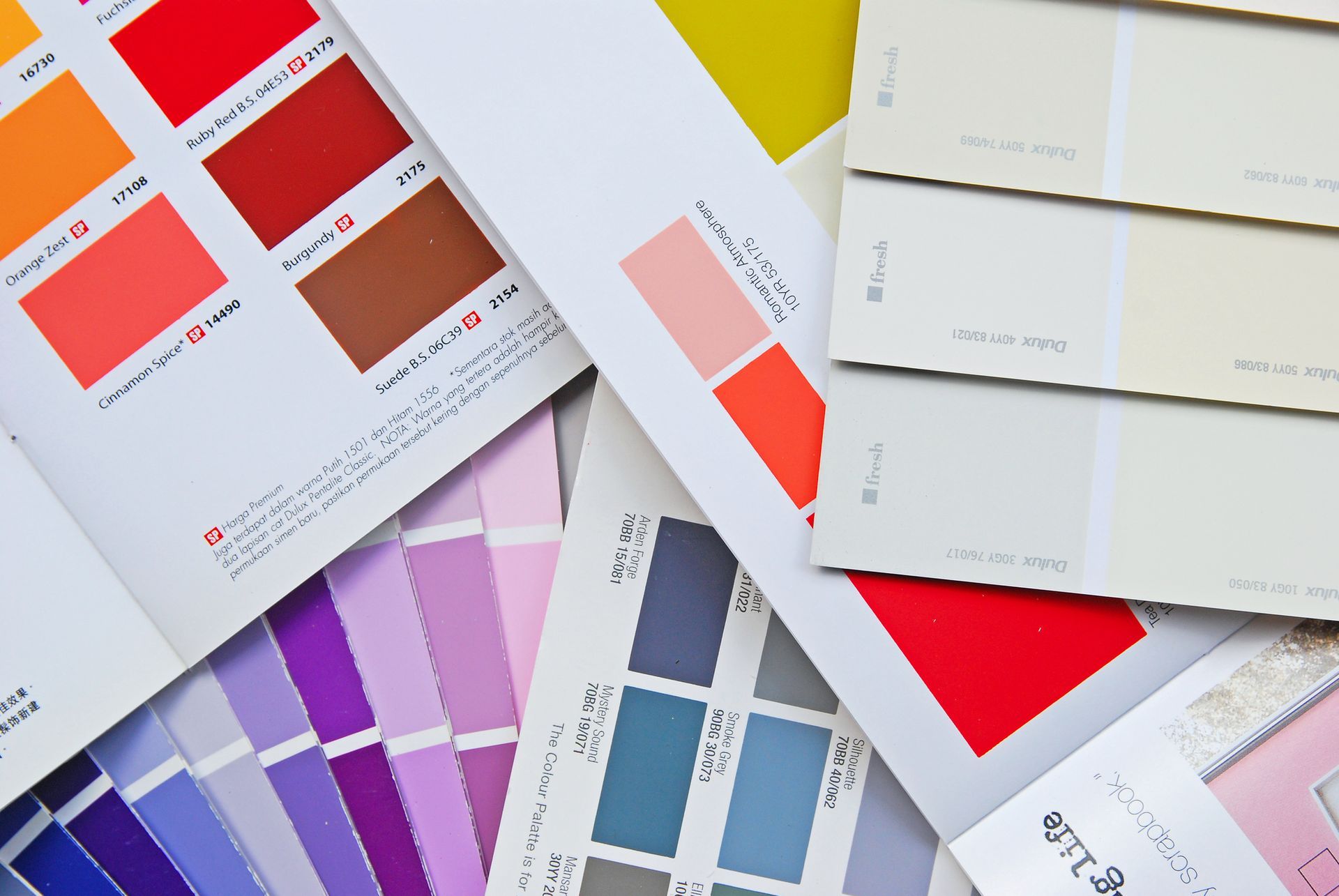Choosing the Right Paint Colors
A Guide to Interior
Color Schemes
When deciding to transform the ambiance of your home or office, few things have the power to make as significant an impact as your choice of paint colors. The colors you select for your interior walls can affect your mood, create visual interest and tie together your overall design scheme. In this guide, we'll walk you through the art and science of choosing the right paint colors for your office or home's interior.
Understanding the Basics of Color Theory
When you begin diving into specific color schemes, it becomes important to understand some basic principles of color theory. Color theory is the science of how colors interact and how they can be combined to create pleasing visuals. Three fundamental aspects to consider are:
1. Color Wheel:
The color wheel is a circular chart that organizes colors in a way that helps us understand their relationships. It consists of primary colors (red, blue, and yellow), secondary colors (orange, green, and purple), and tertiary colors (red-orange, yellow-green, etc.). Complementary colors (those opposite each other on the wheel) create a vibrant contrast, while analogous colors (those adjacent to each other) produce a harmonious blend.
2. Warm vs. Cool Colors:
Colors can be categorized as warm or cool. Warm colors, such as reds, oranges, and yellows, evoke energy and coziness. Cool colors, like blues, greens, and purples, convey calmness and serenity. Consider the mood you want to establish in each room when choosing between warm and cool hues.
3. Light and Dark:
The intensity or value of a color is determined by its brightness or darkness. Light colors can make a room feel more spacious and airy, while dark colors create depth and intimacy. Keep this in mind when deciding which colors to use as a dominant color and as accents.
Harmonious Color Schemes
Now that you have a grasp of color theory, let's explore some popular interior color schemes that can help you achieve a harmonious look in your home:
1. Monochromatic:
A monochromatic color scheme involves using different shades and tones of a single color. For example, you might paint your walls a light blue and use navy and sky blue for accents. Monochromatic schemes create a sense of unity and simplicity while allowing for variation and depth.
2. Analogous:
Analogous color schemes involve selecting colors that are next to each other on the color wheel. For instance, combining green, yellow-green, and yellow creates a harmonious and cohesive palette. This approach is excellent for creating a tranquil and balanced atmosphere.
3. Complementary:
Complementary color schemes pair colors that are directly opposite each other on the color wheel, such as blue and orange or red and green. This creates a striking contrast and adds vibrancy to a space. However, use complementary colors sparingly to avoid overwhelming the room.
4. Triadic:
A triadic color scheme uses three colors that are equally spaced on the color wheel. For example, you could combine red, blue, and yellow for a visually dynamic look. Triadic schemes offer a balanced blend of contrast and variety.
Consider the Room's Purpose
When choosing paint colors, try to consider the function of each room because different colors can evoke different emotions and serve various purposes:
- Living Room:
In the living room, where relaxation and socializing are key, warm and inviting colors like earthy tones (beiges, browns) or warm grays can work well. These colors create a cozy atmosphere and promote conversation.
- Kitchen:
Kitchens often benefit from bright and energetic colors like red, yellow, or light green. These hues can stimulate appetite and create a lively cooking and dining environment.
- Bedroom:
For a tranquil and restful bedroom, cool and calming colors such as soft blues, muted greens, or lavender are excellent choices. These colors can promote relaxation and improve sleep quality.
- Home Office:
In a home office or study, consider colors that boost productivity and concentration. Neutrals like gray and muted blues can provide a serene backdrop, while accents of energizing colors like red or orange can inspire creativity.
Test Before You Paint
Before committing to a color scheme, it's advisable to test paint samples in your intended space. Paint a small section of the wall or create sample boards to observe how the colors appear under different lighting conditions throughout the day.
Natural light can significantly impact how colors look in a room, so be sure to evaluate your choices during both daylight and artificial lighting.
Choosing the right paint colors for your interior spaces is a significant decision that can influence the overall look and feel of your home or office. By understanding the principles of color theory and considering factors like room purpose and lighting, you can confidently select a color scheme that suits your style, enhances your mood and creates a harmonious living or working environment. So, whether you opt for a monochromatic, analogous, complementary or triadic scheme, paint your way to a more vibrant and inviting home or office.
Color Choosing Tips
When it comes to selecting the perfect interior house paint color for your home, there are a few tips that can help guide you in the right direction.
First, consider the colors of any doors, trim or moldings in the room. If these elements contain warm wood tones, you may want to select a complementary color. For example, if your trim is cherry wood, try shades of yellow and golds to create an inviting atmosphere.
If you plan on painting ceilings and doors as well as walls, pick a shade two shades lighter than what is used on the walls. This will bring attention to your crown molding or other architectural details while still keeping things bright and airy. Also be sure to sample out several colors before committing: small swatches of paint are inexpensive and can help determine which hue works best with existing furniture and decor pieces in your space.
Finish Choosing Tips
When it comes to home interior painting, knowing the right finish is the key. The type of paint finish you choose will have a big impact on how your walls, doors, trim and ceilings look and feel. Here are some tips for selecting an interior paint finish that’s right for you:
First, think about the room in question. Is it a high-traffic area or is it more of a quiet space? If it's going to see lots of activity with kids or pets running around, then you'll likely want to choose a higher sheen like semi-gloss or even gloss. These finishes can stand up to wear and tear much better than matte finishes, which tend not to be as durable.
Second, consider your color scheme. Glossy finishes tend to enhance darker colors while flat finishes help mute brighter hues. Our painting professionals will work with you each step of the way making this process smooth and enjoyable.


Contact the Painting Pros of Cleveland at (216) 238-6931 for a FREE "No Hassle" quote .
You'll be glad you did.
The Painting Pros of Cleveland
Hassle-free interior painters near me for your home or business.
Our Service Area
Avon, Avon Lake, Beachwood, Bedford, Berea, Brookpark, Brooklyn, Brooklyn Heights, Chagrin Falls, Cleveland, Cleveland Heights, Cuyahoga Heights, Elyria, Euclid, Fairview Park, Garfield Heights, Highland Heights,
Independence, Lakewood, Linndale, Lorain, Mayfield Heights, Mayfield Village, Middleburg Heights, Newburgh Heights, Northfield, North Olmsted, North Ridgeville, North Royalton, Parma, Parma Heights, Richfield, Rocky River, Seven Hills, Solon, Strongsville, Twinsburg, Warrensville Heights, Westlake
For service in Lake and Geauga counties contact
